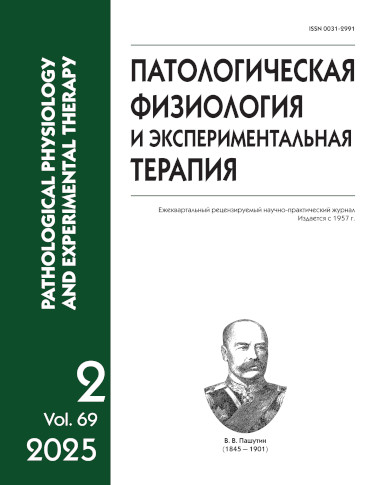Показатели эндогенной интоксикации в динамике беременности у женщин с ВИЧ-инфекцией
DOI:
https://doi.org/10.48612/pfiet/0031-2991.2025.02.54-62Ключевые слова:
беременность разных сроков, молекулы средней массы, эндогенная интоксикация, ВИЧ–инфекция.Аннотация
Введение. Эндотоксикоз – сложный патофизиологический процесс, оказывающий большое влияние на систему «мать-плацента-плод» во время беременности, и в ряде случаев сопровождающийся тканевой деструкцией. Вирус иммунодефицита человека является отягощающим фактором, который может повышать риск развития эндотоксикоза при беременности. Цель работы – оценить у ВИЧ-позитивных женщин в динамике беременности уровень эндогенной интоксикации по содержанию в венозной крови молекул средней массы. Методика. Оценивали уровень эндогенной интоксикации по содержанию молекул средней массы (МСМ) у беременных с ВИЧ-положительным статусом. В исследование были включены 33 женщины в возрасте от 23 до 35 лет. Показатели оценивались в 4 точках: 6-12, 18-22, 28-32, 38-40 недель беременности. В качестве материала для исследования использовали плазму крови. Уровень МСМ определяли спектрофотометрическим методом при λ=238, 254, 260 и 280 нм с последующим расчётом коэффициентов распределения (238/260, 238/280, 280/254). Уровень фракции МСМ выражали в у.е. оптической плотности. Результаты. Установлено достоверное увеличение уровня МСМ при λ=260 нм и λ=280 нм на 38-40 нед. по сравнению с 28-32 нед. (р<0,05). Уровень МСМ 280 был выше перед родами по сравнению с 6-12 нед. беременности (р<0,05). Пептидно-нуклеотидный коэффициент распределения (238/260 нм), а также коэффициент ароматичности (238/280 нм) ниже на 38-40 неделе беременности по сравнению с первым триместром гестационного процесса (р<0,05). Заключение. МСМ, регистрируемые при λ=260 нм и 280 нм, а также коэффициенты ароматичности и пептидно-нуклеотидный коэффициент оказались чувствительными маркерами для мониторинга уровня эндогенной интоксикации у ВИЧ-позитивных беременных. Определение уровня МСМ у ВИЧ-позитивных беременных может использоваться не только как показатель эндогенной интоксикации, но и как косвенный показатель избыточной генерации кислородных метаболитов и перекисного повреждения биосубстратов.Загрузки
Опубликован
2025-06-21
Выпуск
Раздел
Оригинальные исследования
Как цитировать
[1]
2025. Показатели эндогенной интоксикации в динамике беременности у женщин с ВИЧ-инфекцией. Патологическая физиология и экспериментальная терапия. 69, 2 (Jun. 2025), 54–62. DOI:https://doi.org/10.48612/pfiet/0031-2991.2025.02.54-62.













